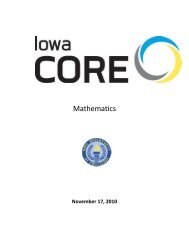The Arc's Self-Determination Scale: Procedural Guidelines
The Arc's Self-Determination Scale: Procedural Guidelines
The Arc's Self-Determination Scale: Procedural Guidelines
You also want an ePaper? Increase the reach of your titles
YUMPU automatically turns print PDFs into web optimized ePapers that Google loves.
determination as an educational outcome. <strong>The</strong> <strong>Scale</strong> has utility as<br />
one component in an overall effort to promote self-determination<br />
by involving the student in his or her educational planning and<br />
decision-making process. In addition, the <strong>Scale</strong> can provide the<br />
information needed to develop goals and objectives related to selfdetermined<br />
behavior. Items on the <strong>Scale</strong> were written at a fourthgrade<br />
reading level (lower when possible). <strong>The</strong> <strong>Scale</strong> has been<br />
field-tested and validated with students with cognitive disabilities<br />
receiving special education services around the country. <strong>The</strong><br />
administration process includes the latitude for educators to<br />
provide a series of accommodations, from reading the test items<br />
and explaining various words and concepts for the student to<br />
transcribing student responses if necessary (see Administration<br />
chapter).<br />
<strong>The</strong> first potential use of <strong>The</strong> Arc’s <strong>Self</strong>-<strong>Determination</strong> <strong>Scale</strong><br />
is to generate discussion about items the student finds interesting,<br />
problematic, or wants to discuss more broadly. Ideally, a student<br />
could use the <strong>Scale</strong> with minimal instruction from a teacher or<br />
another person. However, students will vary considerably in the<br />
level of support they need to complete the assessment. Many<br />
students with mild levels of cognitive disabilities should be able to<br />
work through the <strong>Scale</strong> independently or semi-independently. This<br />
process, in and of itself, has merit. <strong>The</strong> authors’ experiences with<br />
the <strong>Scale</strong> indicated that students were motivated to engage in the<br />
activity because it focused on their interests, abilities and feelings.<br />
On numerous occasions students indicated that no one had ever<br />
asked them about their feelings about control over and choices in<br />
their lives. If students are particularly sensitive about or focused on<br />
“scores” and “comparisons” between themselves and others, the<br />
<strong>Scale</strong> could be completed, not scored, and each topic area could<br />
form the basis for discussion about students’ beliefs, desires,<br />
abilities, limitations, and future plans.<br />
<strong>The</strong> second use of the <strong>Scale</strong> involves scoring it and comparing<br />
Total, domain and subdomain scores with <strong>Scale</strong> norms and, more<br />
importantly, examining individual strengths and weaknesses across<br />
the domains. <strong>The</strong> normed data is provided only as a point of<br />
comparison, not so that students who perform below the mean<br />
should feel a sense of failure or otherwise use the information in a<br />
pejorative manner. Normed data can provide students and teachers<br />
with honest feedback upon which to base future interventions.<br />
One reason that students lack self-determination is that they<br />
experience overprotection from family members and school<br />
personnel. If students invest in the assessment process as<br />
something they want to do to benefit themselves, they will use<br />
information comparing their performance with that of others as a<br />
call to action. It is critical that the teacher or person working with<br />
12
















